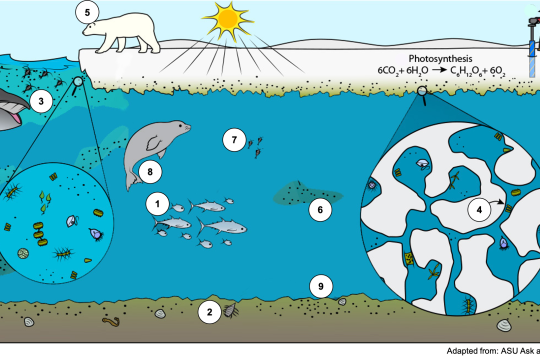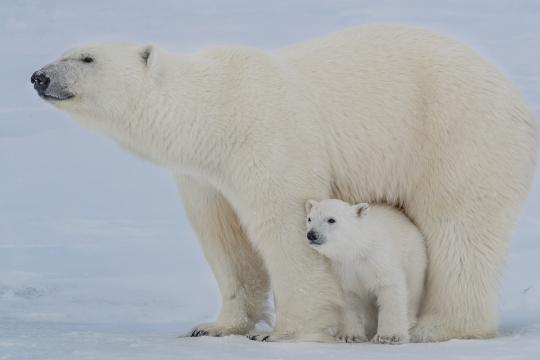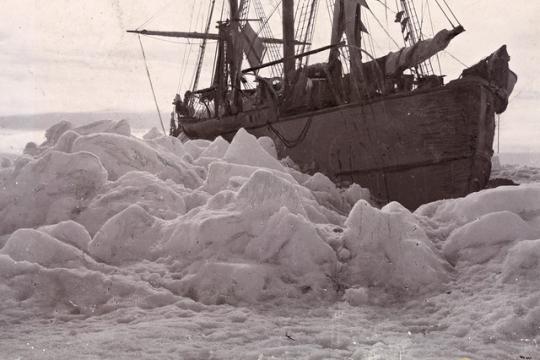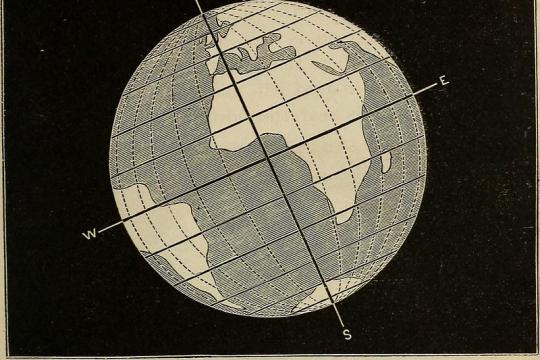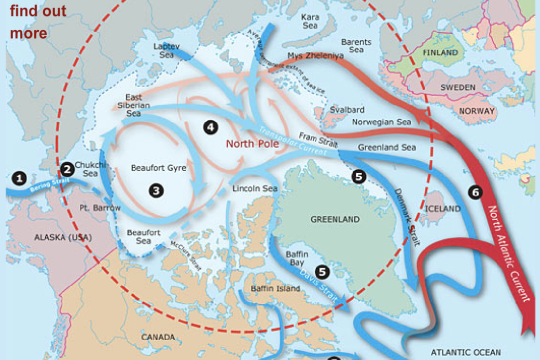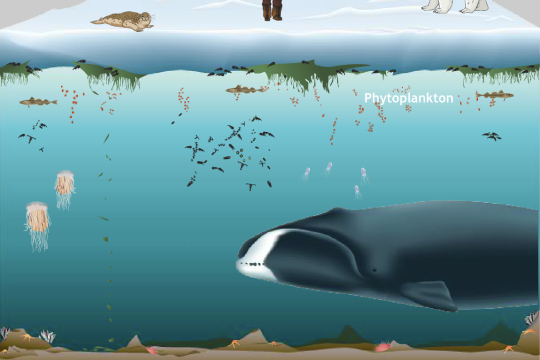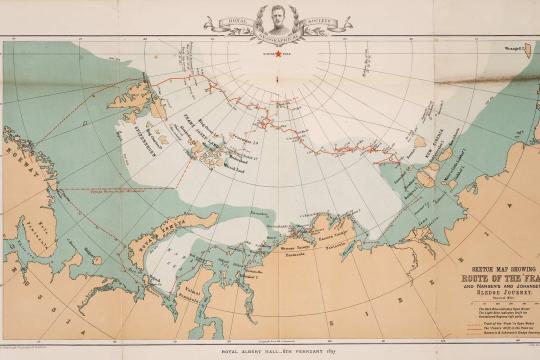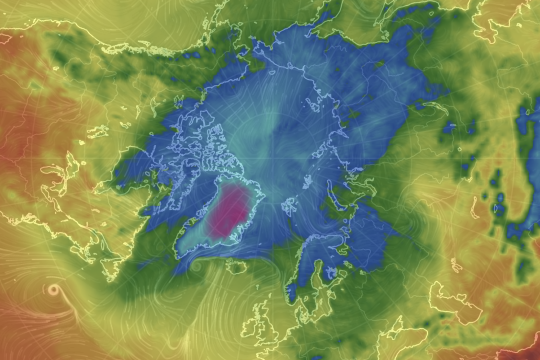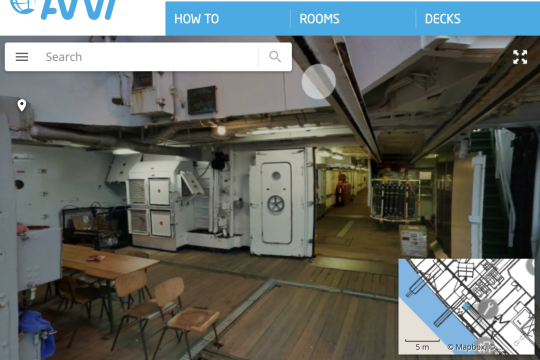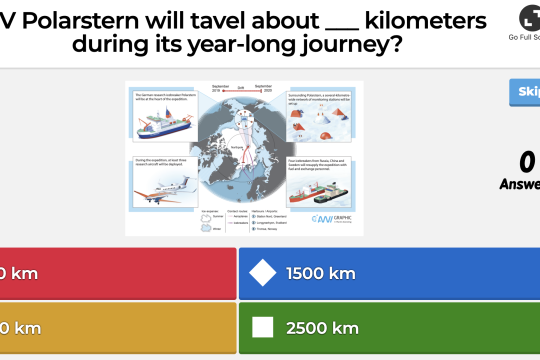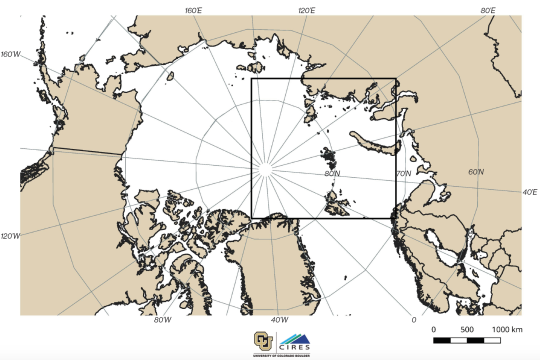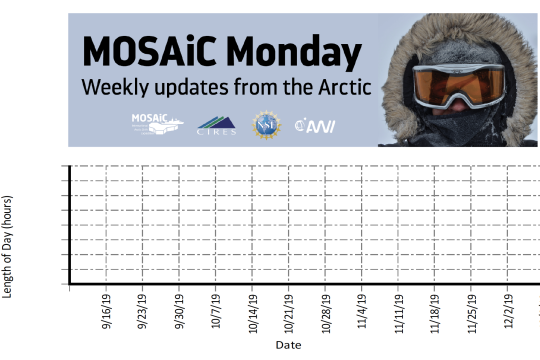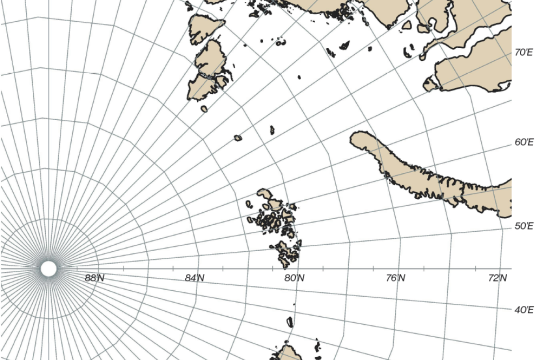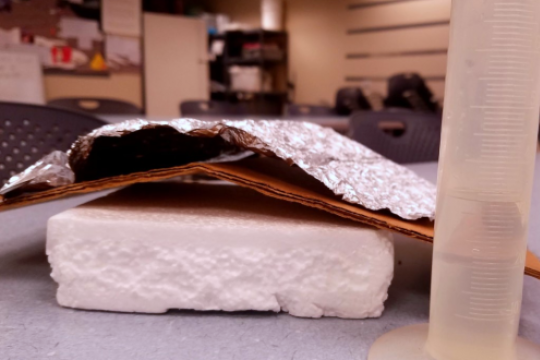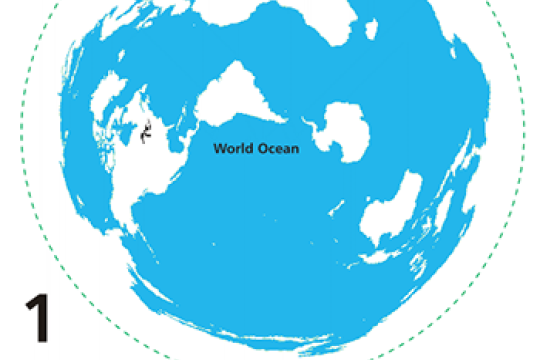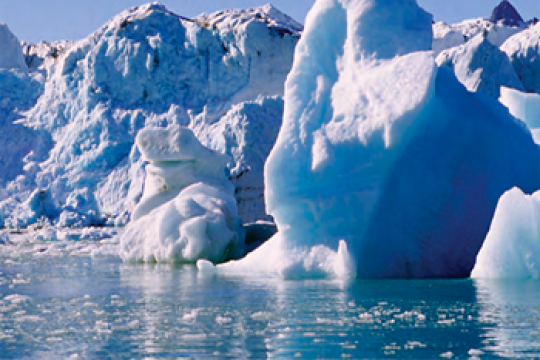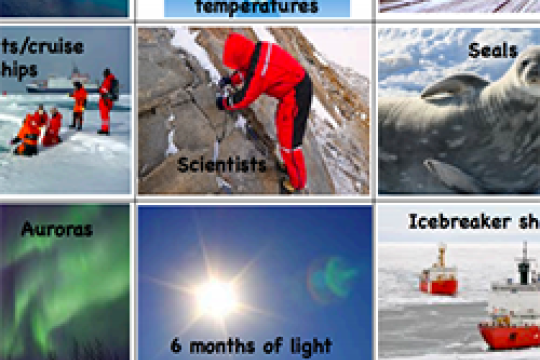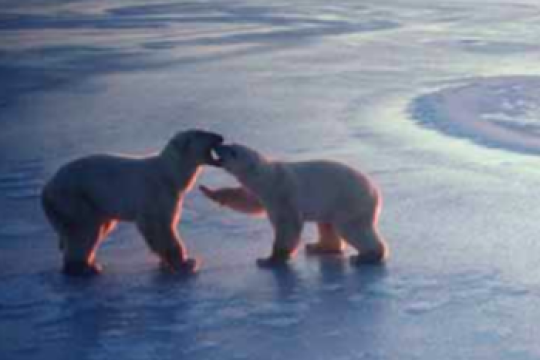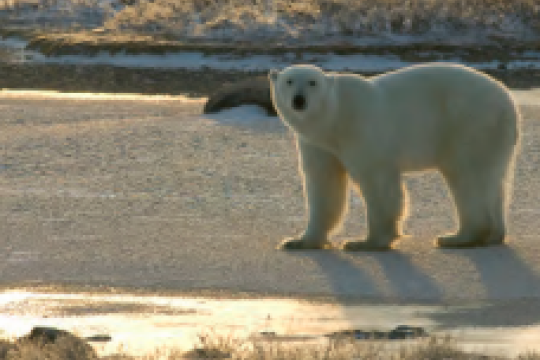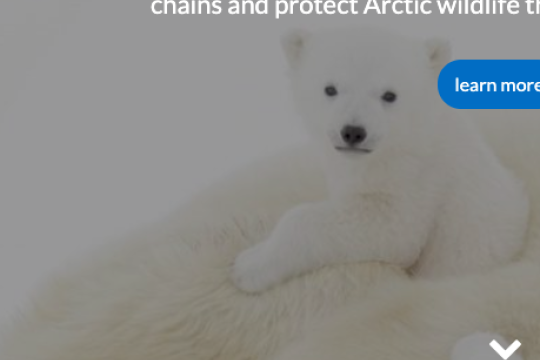3-5
Quick Bite: Fill in the Food Web
What does an Arctic food web look like, and what are the relationships between its members? Find out in this Quick Bite activity.
Quick bite
Subject: Constructing explanations, Developing and using models, Ecosystems, Life science, mosaic monday, Polar Bears
Grade Level: 3-5, Middle School, High School
Developer: CIRES
What does an Arctic food web look like, and what are the relationships between its members? Find out in this Quick Bite activity.
Quick bite
Subject: Constructing explanations, Developing and using models, Ecosystems, Life science, mosaic monday, Polar Bears
Grade Level: 3-5, Middle School, High School
Developer: CIRES
Quick Bite: Polar Bear Adaptations
How are polar bears adapted to their chilly environment? Photo credit: Lianna Nixon, CIRES/CU Boulder
Project of Mosaic Quick bite
Subject: Constructing explanations, Life science, mosaic monday, Polar Bears
Grade Level: 3-5, Middle School, High School
Developer: CIRES
How are polar bears adapted to their chilly environment? Photo credit: Lianna Nixon, CIRES/CU Boulder
Project of Mosaic Quick bite
Subject: Constructing explanations, Life science, mosaic monday, Polar Bears
Grade Level: 3-5, Middle School, High School
Developer: CIRES
Quick Bite: Earth vs. Moon
Why are the Moon and Earth so different temperature-wise if they are essentially the same distance from the Sun?
Quick bite
Subject: Atmosphere, Climate, Constructing explanations, Earth science, mosaic monday
Grade Level: 3-5, Middle School, High School
Developer: CIRES
Why are the Moon and Earth so different temperature-wise if they are essentially the same distance from the Sun?
Quick bite
Subject: Atmosphere, Climate, Constructing explanations, Earth science, mosaic monday
Grade Level: 3-5, Middle School, High School
Developer: CIRES
Quick Bite: Arctic Adaptations
Did you know that some Arctic foxes change color depending on the season? In this Quick Bite activity, your students will hypothesize why this happens and what it means for the Arctic foxes' survival. Photo credit: Michael Ginzburg
Project of Mosaic Quick bite
Subject: Constructing explanations, Ecosystems, Life science, mosaic monday
Grade Level: 3-5, Middle School, High School
Developer: CIRES
Did you know that some Arctic foxes change color depending on the season? In this Quick Bite activity, your students will hypothesize why this happens and what it means for the Arctic foxes' survival. Photo credit: Michael Ginzburg
Project of Mosaic Quick bite
Subject: Constructing explanations, Ecosystems, Life science, mosaic monday
Grade Level: 3-5, Middle School, High School
Developer: CIRES
I Notice, I Wonder: Polarstern vs. Fram
In this MOSAiC Quick Bite activity, compare the rooms inside the Fram ship from the 1893 expedition to the Arctic with the modern Polarstern.
Project of Mosaic Quick bite
Subject: Expeditions, mosaic monday
Grade Level: 3-5, Middle School, High School
Developer: CIRES
In this MOSAiC Quick Bite activity, compare the rooms inside the Fram ship from the 1893 expedition to the Arctic with the modern Polarstern.
Project of Mosaic Quick bite
Subject: Expeditions, mosaic monday
Grade Level: 3-5, Middle School, High School
Developer: CIRES
Learn About the Equinox
Before she left to spend several weeks in the Arctic Ocean aboard an icebreaker on the MOSAiC expedition, PolarTREC educator Katie Gavenus put together a collection of educational resources for teaching about the equinox. Whether you're a fan of kinesthetic activities, art, or video lessons, there's something here for you!
Lesson plan
Subject: Constructing explanations, Developing and using models, Earth science
Grade Level: 3-5, Middle School, High School
Before she left to spend several weeks in the Arctic Ocean aboard an icebreaker on the MOSAiC expedition, PolarTREC educator Katie Gavenus put together a collection of educational resources for teaching about the equinox. Whether you're a fan of kinesthetic activities, art, or video lessons, there's something here for you!
Lesson plan
Subject: Constructing explanations, Developing and using models, Earth science
Grade Level: 3-5, Middle School, High School
Arctic Ocean Circulation
In this interactive graphic, students click on Arctic Ocean currents to follow sea water as it enters and exits the Arctic.
Project of Mosaic Quick bite
Subject: Oceans and ocean circulation
Grade Level: 3-5, Middle School, High School
In this interactive graphic, students click on Arctic Ocean currents to follow sea water as it enters and exits the Arctic.
Project of Mosaic Quick bite
Subject: Oceans and ocean circulation
Grade Level: 3-5, Middle School, High School
Arctic Ocean Ecosystem
In this interactive graphic, students click on animals to learn more about their role within the Arctic Ocean ecosystem.
Project of Mosaic Quick bite
Subject: Ecosystems
Grade Level: 3-5, Middle School, High School
In this interactive graphic, students click on animals to learn more about their role within the Arctic Ocean ecosystem.
Project of Mosaic Quick bite
Subject: Ecosystems
Grade Level: 3-5, Middle School, High School
Route of the Fram Expedition (1893-1896)
On July 5th, 1893, the Fram set sail from Tromsø, Norway to try to reach the highest latitude ever attained. Fridtjof Nansen, leader of the Fram expedition, attempted to freeze a custom-built wooden ship in sea ice and use Arctic currents to drift north. See where the Fram--and Nansen--drifted and dogsledded during their three years in the Arctic.
Project of Mosaic Data visualization
Subject: Expeditions, Geography, Oceans and ocean circulation
Grade Level: K-2, 3-5, Middle School, High School, University/college
On July 5th, 1893, the Fram set sail from Tromsø, Norway to try to reach the highest latitude ever attained. Fridtjof Nansen, leader of the Fram expedition, attempted to freeze a custom-built wooden ship in sea ice and use Arctic currents to drift north. See where the Fram--and Nansen--drifted and dogsledded during their three years in the Arctic.
Project of Mosaic Data visualization
Subject: Expeditions, Geography, Oceans and ocean circulation
Grade Level: K-2, 3-5, Middle School, High School, University/college
Fluid Earth Viewer
Explore atmospheric and oceanographic conditions in the Arctic or anywhere else on the globe with this incredible data visualization tool.
Data visualization
Subject: Analyzing and interpreting data, Atmosphere, Earth science, Geography, Oceans and ocean circulation
Grade Level: 3-5, Middle School, High School, University/college, Adult
Developer: Byrd Polar and Climate Research Center
Explore atmospheric and oceanographic conditions in the Arctic or anywhere else on the globe with this incredible data visualization tool.
Data visualization
Subject: Analyzing and interpreting data, Atmosphere, Earth science, Geography, Oceans and ocean circulation
Grade Level: 3-5, Middle School, High School, University/college, Adult
Developer: Byrd Polar and Climate Research Center
Tour the Polarstern
Did you know the Polarstern is equipped with an indoor swimming pool? Hop aboard the Polarstern for this all-access, 3D virtual tour!
Project of Mosaic Quick bite
Subject: Engineering and technology, Expeditions
Grade Level: 3-5, Middle School, High School
Developer: CIRES
Did you know the Polarstern is equipped with an indoor swimming pool? Hop aboard the Polarstern for this all-access, 3D virtual tour!
Project of Mosaic Quick bite
Subject: Engineering and technology, Expeditions
Grade Level: 3-5, Middle School, High School
Developer: CIRES
MOSAiC in Numbers Trivia
What temperatures will the MOSAiC researchers endure during the expedition? How far with the Polarstern drift during its 13 month journey? Introduce your students to the MOSAiC expedition and count down to the expedition launch with this MOSAiC in Numbers trivia quiz.
Project of Mosaic Game
Subject: Expeditions
Grade Level: K-2, 3-5, Middle School, High School
Developer: CIRES
What temperatures will the MOSAiC researchers endure during the expedition? How far with the Polarstern drift during its 13 month journey? Introduce your students to the MOSAiC expedition and count down to the expedition launch with this MOSAiC in Numbers trivia quiz.
Project of Mosaic Game
Subject: Expeditions
Grade Level: K-2, 3-5, Middle School, High School
Developer: CIRES
Where is the Arctic?
Have your students label and color the countries around the Arctic and do some research about the various people who live in the Arctic region. How is the 'Arctic' defined geographically? Note: We suggest using the this map in conjunction with the "Tracking the Polarstern" map (download both maps and copy them front to back for your students). The inset box on the "Where is the Arctic?" map shows the boundaries for the "Tracking the Polarstern" map.
Project of Mosaic Quick bite
Subject: Geography
Grade Level: K-2, 3-5, Middle School, High School, University/college
Developer: CIRES
Have your students label and color the countries around the Arctic and do some research about the various people who live in the Arctic region. How is the 'Arctic' defined geographically? Note: We suggest using the this map in conjunction with the "Tracking the Polarstern" map (download both maps and copy them front to back for your students). The inset box on the "Where is the Arctic?" map shows the boundaries for the "Tracking the Polarstern" map.
Project of Mosaic Quick bite
Subject: Geography
Grade Level: K-2, 3-5, Middle School, High School, University/college
Developer: CIRES
MOSAiC Data Logbook
Your students can be MOSAiC scientists by analyzing real-time data from the expedition each week. Download the MOSAiC Data Log Book and look for the data in each MOSAiC Monday newsletter throughout the expedition. Over time, your students will be able to use the data they've graphed to make interpretations about seasonality in the Arctic and Arctic weather conditions. *Note: We expect data to fall within the following ranges: Length of Day: 0 to 24 hours Temperature: -40 to 14 °C Sea Ice Extent: 3 to 15 million km2 Download the MOSAiC Data Log Book
Project of Mosaic Quick bite
Subject: Analyzing and interpreting data, Earth science, Expeditions
Grade Level: K-2, 3-5, Middle School, High School, University/college
Developer: CIRES
Your students can be MOSAiC scientists by analyzing real-time data from the expedition each week. Download the MOSAiC Data Log Book and look for the data in each MOSAiC Monday newsletter throughout the expedition. Over time, your students will be able to use the data they've graphed to make interpretations about seasonality in the Arctic and Arctic weather conditions. *Note: We expect data to fall within the following ranges: Length of Day: 0 to 24 hours Temperature: -40 to 14 °C Sea Ice Extent: 3 to 15 million km2 Download the MOSAiC Data Log Book
Project of Mosaic Quick bite
Subject: Analyzing and interpreting data, Earth science, Expeditions
Grade Level: K-2, 3-5, Middle School, High School, University/college
Developer: CIRES
Tracking the Polarstern
The route that the Polarstern will take across the Central Arctic is not fully known. Since the ship will be frozen in the Arctic sea ice and drifting along with it wherever it goes, we can only make predictions about the path will follow. Each week we will provide you with the latitude and longitude coordinates of the Polarstern so that your students can track its journey across the Arctic in your classroom. Download this map and plot your first set of coordinates!
Project of Mosaic Quick bite
Subject: Expeditions, Geography
Grade Level: K-2, 3-5, Middle School, High School, University/college
Developer: CIRES
The route that the Polarstern will take across the Central Arctic is not fully known. Since the ship will be frozen in the Arctic sea ice and drifting along with it wherever it goes, we can only make predictions about the path will follow. Each week we will provide you with the latitude and longitude coordinates of the Polarstern so that your students can track its journey across the Arctic in your classroom. Download this map and plot your first set of coordinates!
Project of Mosaic Quick bite
Subject: Expeditions, Geography
Grade Level: K-2, 3-5, Middle School, High School, University/college
Developer: CIRES
Keep it Cool
When you put on layers to stay warm in the winter, or use a cooler to keep food cool, have you ever wondered about the science of thermal energy transfer? Challenge your students to utilize their understanding of thermal energy transfer and transformation to develop a simple, lightweight, and efficient method for storing and transporting ice cores.
NGSS Aligned Lesson plan
Subject: Engineering and technology, Physical science
Grade Level: 3-5, Middle School
Developer: Byrd Polar and Climate Research Center
When you put on layers to stay warm in the winter, or use a cooler to keep food cool, have you ever wondered about the science of thermal energy transfer? Challenge your students to utilize their understanding of thermal energy transfer and transformation to develop a simple, lightweight, and efficient method for storing and transporting ice cores.
NGSS Aligned Lesson plan
Subject: Engineering and technology, Physical science
Grade Level: 3-5, Middle School
Developer: Byrd Polar and Climate Research Center
One World Ocean
In this hands-on activity, students learn about ocean currents and the difference between salt and fresh water using colored ice cubes and glasses of fresh and salt water.
NGSS Aligned Lesson plan
Subject: Developing and using models, Earth science, Oceans and ocean circulation, Physical science
Grade Level: 3-5, Middle School
Developer: Teach Engineering
In this hands-on activity, students learn about ocean currents and the difference between salt and fresh water using colored ice cubes and glasses of fresh and salt water.
NGSS Aligned Lesson plan
Subject: Developing and using models, Earth science, Oceans and ocean circulation, Physical science
Grade Level: 3-5, Middle School
Developer: Teach Engineering
Top of the World
Students will identify, locate, outline, and map the Arctic Circle, including the countries that lie within its boundaries. Students will define the Arctic region by latitude, temperature, and tree line. Students will compare and contrast the human and environmental characteristics of the North and South Poles, the equator, and their home town.
Lesson plan
Subject: Geography
Grade Level: 3-5, Middle School
Developer: Polar Bears International
Students will identify, locate, outline, and map the Arctic Circle, including the countries that lie within its boundaries. Students will define the Arctic region by latitude, temperature, and tree line. Students will compare and contrast the human and environmental characteristics of the North and South Poles, the equator, and their home town.
Lesson plan
Subject: Geography
Grade Level: 3-5, Middle School
Developer: Polar Bears International
To the Ends of the Earth: Comparing the Arctic and Antarctic
Students sort picture cards using a Venn diagram to find similarities and differences between the Arctic and Antarctic.
NGSS Aligned Lesson plan
Subject: Earth science, Geography
Grade Level: 3-5, Middle School
Developer: U.S. Ice Drilling Program
Students sort picture cards using a Venn diagram to find similarities and differences between the Arctic and Antarctic.
NGSS Aligned Lesson plan
Subject: Earth science, Geography
Grade Level: 3-5, Middle School
Developer: U.S. Ice Drilling Program
Design and Build a Sea Ice Drifter
In an engineering design challenge, students learn about sea ice and sea ice observation technology to build and design their own sea ice drifter.
Project of Mosaic Lesson plan
Subject: Asking questions, Constructing explanations, Engineering and technology, Physical science, Sea ice
Grade Level: 3-5
Developer: SMILE Oregon State
In an engineering design challenge, students learn about sea ice and sea ice observation technology to build and design their own sea ice drifter.
Project of Mosaic Lesson plan
Subject: Asking questions, Constructing explanations, Engineering and technology, Physical science, Sea ice
Grade Level: 3-5
Developer: SMILE Oregon State
Polar Bears in a Warming World:A Climate Change Lesson
Students will locate and distinguish the four major sea ice eco-regions in the Arctic and explore the impacts of sea ice loss over time due to climate change and the ensuing threats these changes may have on the Arctic ecosystem and its inhabitants.
Lesson plan
Subject: Climate, Constructing explanations, Earth science, Ecosystems, Life science, Sea ice
Grade Level: 3-5, Middle School
Developer: Polar Bears International
Students will locate and distinguish the four major sea ice eco-regions in the Arctic and explore the impacts of sea ice loss over time due to climate change and the ensuing threats these changes may have on the Arctic ecosystem and its inhabitants.
Lesson plan
Subject: Climate, Constructing explanations, Earth science, Ecosystems, Life science, Sea ice
Grade Level: 3-5, Middle School
Developer: Polar Bears International
Jelly Critters
Students conduct research on species of gelatinous zooplankton, and learn about their importance in the Arctic food web.
Lesson plan
Subject: Climate, Ecosystems, Geography, Life science, Obtaining and evaluating information
Grade Level: 3-5, Middle School
Developer: NOAA
Students conduct research on species of gelatinous zooplankton, and learn about their importance in the Arctic food web.
Lesson plan
Subject: Climate, Ecosystems, Geography, Life science, Obtaining and evaluating information
Grade Level: 3-5, Middle School
Developer: NOAA
Extreme Ecosystems: A Biodiversity Lesson
Students will identify and categorize plants and animals in the Arctic with an emphasis on which animals are endangered, threatened, or a species of special concern. Students will participate in individual species studies, presentations, and an interactive class trivia game.
Lesson plan
Subject: Ecosystems, ELA, Life science, Obtaining and evaluating information
Grade Level: 3-5, Middle School
Developer: Polar Bears International
Students will identify and categorize plants and animals in the Arctic with an emphasis on which animals are endangered, threatened, or a species of special concern. Students will participate in individual species studies, presentations, and an interactive class trivia game.
Lesson plan
Subject: Ecosystems, ELA, Life science, Obtaining and evaluating information
Grade Level: 3-5, Middle School
Developer: Polar Bears International
EcoChains: Arctic Life Game
The EcoChains Arctic Life game accurately models the effects of climate change on wildlife food-webs. The game shows how human actions such as the development of alternative energy can influence carbon pollution.
Game
Subject: Arguing from evidence, Constructing explanations, Earth science, Ecosystems, Life science, Obtaining and evaluating information, Sea ice
Grade Level: 3-5, Middle School, High School
Developer: Ecochains
The EcoChains Arctic Life game accurately models the effects of climate change on wildlife food-webs. The game shows how human actions such as the development of alternative energy can influence carbon pollution.
Game
Subject: Arguing from evidence, Constructing explanations, Earth science, Ecosystems, Life science, Obtaining and evaluating information, Sea ice
Grade Level: 3-5, Middle School, High School
Developer: Ecochains
